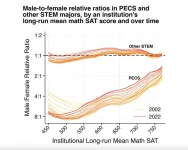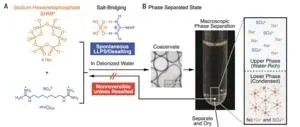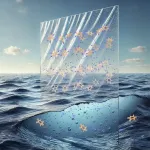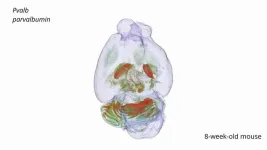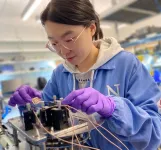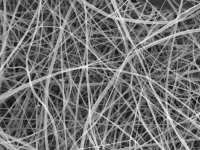(Press-News.org) Nationally, men in colleges and universities currently outpace women in earning physics, engineering, and computer science (PECS) degrees by an approximate ratio of 4 to 1. To better understand the factors driving these gaps, NYU researchers analyzed bachelor’s degrees awarded in the US from 2002-2022, and found that the most selective universities by math SAT scores have nearly closed the PECS gender gap, while less selective universities have seen it widen dramatically.
“These findings challenge our understanding of gender inequality in STEM education,” says Joseph Cimpian, the study’s lead author and professor of economics and education policy at NYU Steinhardt and NYU Wagner. “We’re seeing two divergent trends: at highly selective universities, women’s representation in these fields is approaching parity in PECS, while at institutions serving the majority of American students, women’s representation in PECS has stagnated or declined. This has profound implications for economic equality and innovation in our technological workforce.”
Cimpian and his co-author, Jo R. King—a doctoral student at NYU Wagner—analyzed data on over 34 million bachelor’s degrees awarded between 2002 and 2022, using the Integrated Postsecondary Education Data System (IPEDS) for a near-census of degrees awarded in the US.
Their results, published in Science, identified average math SAT scores as the most predictive institutional factor of male to female representation in PECS. In 2002, institutions serving students with the highest math SAT scores (around 770 and higher) had 2 men for every 1 woman in PECS fields and narrowed that ratio to 3 men to 2 women in 2022. For schools serving students with much lower SAT scores (around 450), the initial ratio of 3 men to 1 woman in 2002 increased to 7 men for every 1 woman by 2022.
They also studied patterns of initial enrollment in these math-intensive majors and found that the most selective schools—such as Ivy League schools and flagship public research universities—improved recruitment and retention of women in PECS, while less selective schools struggled in both recruitment and retention over the past two decades.
In contrast to PECS fields, other STEM disciplines maintain roughly equal gender representation across all institution types. Cimpian notes that this distinction highlights the unique challenges in physics, engineering, and computer science.
The researchers supplemented their analyses with two additional nationally representative datasets to assess whether the divergent patterns they observed across institutions could be explained by individual student factors. They found that the different pattern of women’s PECS representation across institutions persists even after accounting for the previously identified factor of student SAT scores as well as prior intentions to major in PECS. Notably, women of color face compounded challenges, remaining underrepresented even at institutions where overall gender balance is improving.
“Our findings suggest we need to redirect resources to where the gaps are largest,” says Cimpian. “While it’s crucial to maintain support for institutions making progress toward equity, we must better understand and address the growing challenges at less selective institutions, where most American students pursue their degrees.”
This study was supported in part by the Institute of Education Sciences (#R305B200010).
END
Math-selective US universities reduce gender gap in STEM fields
The most selective universities approach gender parity in physics, engineering, and computer science, while less selective institutions see widening gaps
2024-11-21
ELSE PRESS RELEASES FROM THIS DATE:
Researchers identify previously unknown compound in drinking water
2024-11-21
A team of researchers from the United States and Switzerland have reported the discovery of a previously unknown compound in chloraminated drinking water. Inorganic chloramines are commonly used to disinfect drinking water to safeguard public health from diseases like cholera and typhoid fever. It’s estimated that more than 113 million people in the United States alone drink chloraminated water.
The researchers have now identified chloronitramide anion, chemically expressed as Cl–N–NO2−, as an end product of inorganic chloramine decomposition. While its toxicity is not presently known, its prevalence and similarity to other ...
Chloronitramide anion – a newly characterized contaminant prevalent in chloramine treated tap water
2024-11-21
Many public water systems in the United States use inorganic chloramines to disinfect drinking water, but their decomposition products have long been a mystery. In a new study, researchers report the discovery of chloronitramide anion – a compound whose existence, though not identity, has been known for 30 years. Detected in the tap water of millions of Americans, this compound’s toxicity remains untested, prompting calls for immediate toxicological evaluation and raising questions about the safety of chloramine in public water supplies. For over a century, chemical disinfection of public water ...
Population connectivity shapes cultural complexity in chimpanzees
2024-11-21
Cultural complexity in chimpanzees depends on migration and interaction between groups, echoing early human patterns of cultural evolution, researchers report in a new study. The findings offer insight into the development of cumulative culture in early hominins. Culture, defined as a set of socially learned behaviors, has been increasingly documented across various animal species. However, human culture stands out for its complexity and cumulative nature, where cultural knowledge builds upon previous innovations. While chimpanzees – humans’ closest relatives – demonstrate a variety of cultural ...
Direct hearing tests show that minke whales can hear high-frequency sounds
2024-11-21
For the first time, scientists have directly measured the hearing range of minke whales, discovering that the species can detect high-frequency sounds as high as 90 kilohertz (kHz), according to a new study, demonstrating hearing sensitivity far greater than previously believed. The findings suggest that baleen whales – the planet’s largest mammals – may be even more impacted by anthropogenic ocean noise than currently recognized but have been excluded from regulatory consideration due to underestimated hearing ranges. ...
Whale-ship collision risk mapped across Earth’s oceans
2024-11-21
By mapping global ship traffic and whale habitats, researchers found that 92% of whale habitats overlap with shipping routes, illuminating hotspots for whale-ship collision risk, according to a new study. Although only 7% of high-risk areas currently contain management strategies to reduce ship strikes, the findings show that expanding efforts to just 2.6% of the ocean’s surface could significantly reduce these fatal collisions, aiding whale conservation amid booming global shipping. “Mitigating the negative environmental impacts of marine shipping is essential ...
Bye-bye microplastics: new plastic is recyclable and fully ocean-degradable
2024-11-21
Researchers led by Takuzo Aida at the RIKEN Center for Emergent Matter Science (CEMS) have developed a new durable plastic that won’t pollute our oceans. The new material is as strong as conventional plastics and biodegradable, but what makes it special is that it breaks down in seawater. The new plastic is therefore expected to help reduce harmful microplastic pollution that accumulates in oceans and soil and eventually enters the food chain. The experimental findings were published Nov 22 in Science.
Scientists have been trying to develop safe and sustainable materials that can replace traditional plastics, which are non-sustainable and harm the environment. While ...
Unveiling nature of metal-support interaction: AI-driven breakthrough in catalysis
2024-11-21
How can Artificial Intelligence (AI) help accelerate scientific discovery based on vast amounts of experimental data? A new study by Prof. LI Weixue's team from the University of Science and Technology of China (USTC) of the Chinese Academy of Sciences shows how this can be achieved in heterogonous catalysis. The results were recently published in Science.
By integrating interpretable AI with experimental data, domain knowledge, and first-principles simulations, the researchers established a general theory of metal-support interaction (MSI), which is one of the most important pillars in catalysis.
Supported metal catalysts ...
New imaging method enables detailed RNA analysis of the whole brain
2024-11-21
Researchers at Karolinska Institutet and Karolinska University Hospital have developed a groundbreaking microscopy method that enables detailed three-dimensional (3D) RNA analysis at cellular resolution in whole intact mouse brains. The new method, called TRISCO, has the potential to transform our understanding of brain function, both in normal conditions and in disease, according to the new study published in Science.
Despite great advances in RNA analysis, linking RNA data to its spatial context has long been a challenge, especially in intact 3D tissue volumes. The TRISCO method now makes it possible to perform three-dimensional RNA imaging of whole ...
Stability of perovskite solar cells doubled with protective coating
2024-11-21
Northwestern University scientists have developed a new protective coating that significantly extends the life of perovskite solar cells, making them more practical for applications outside the lab.
Although perovskite solar cells are more efficient and less expensive than traditional silicon solar cells, perovskite has, until now, been limited by its lack of long-term stability. Typically, perovskite solar cells uses an ammonium-based coating layer to enhance efficiency. While effective, ammonium-based layers degrade under environmental stress, such as heat and moisure.
Northwestern ...
Chemists create world’s thinnest spaghetti
2024-11-21
The world’s thinnest spaghetti, about 200 times thinner than a human hair, has been created by a UCL-led research team.
The spaghetti is not intended to be a new food but was created because of the wide-ranging uses that extremely thin strands of material, called nanofibers, have in medicine and industry.
Nanofibers made of starch – produced by most green plants to store excess glucose – are especially promising and could be used in bandages to aid wound healing (as the nanofiber mats are highly porous, allowing water and moisture in but keeping ...
LAST 30 PRESS RELEASES:
The Ceramic Society of Japan’s Oxoate Ceramics Research Association launches new international book project
Heart-brain connection: international study reveals the role of the vagus nerve in keeping the heart young
Researchers identify Rb1 as a predictive biomarker for a new therapeutic strategy in some breast cancers
Survey reveals ethical gaps slowing AI adoption in pediatric surgery
Stimulant ADHD medications work differently than thought
AI overestimates how smart people are, according to HSE economists
HSE researchers create genome-wide map of quadruplexes
Scientists boost cell "powerhouses" to burn more calories
Automatic label checking: The missing step in making reliable medical AI
Low daily alcohol intake linked to 50% heightened mouth cancer risk in India
American Meteorological Society announces Rick Spinrad as 2026 President-Elect
Biomass-based carbon capture spotlighted in newly released global climate webinar recording
Illuminating invisible nano pollutants: advanced bioimaging tracks the full journey of emerging nanoscale contaminants in living systems
How does age affect recovery from spinal cord injury?
Novel AI tool offers prognosis for patients with head and neck cancer
Fathers’ microplastic exposure tied to their children’s metabolic problems
Research validates laboratory model for studying high-grade serous ovarian cancer
SIR 2026 delivers transformative breakthroughs in minimally invasive medicine to improve patient care
Stem Cell Reports most downloaded papers of 2025 highlight the breadth and impact of stem cell research
Oxford-led study estimates NHS spends around 3% of its primary and secondary care budget on the health impacts of heat and cold in England
A researcher’s long quest leads to a smart composite breakthrough
Urban wild bees act as “microbial sensors” of city health.
New study finds where you live affects recovery after a hip fracture
Forecasting the impact of fully automated vehicle adoption on US road traffic injuries
Alcohol-related hospitalizations from 2016 to 2022
Semaglutide and hospitalizations in patients with obesity and established cardiovascular disease
Researchers ‘listen in’ to embryo-mother interactions during implantation using a culture system replicating the womb lining
How changing your diet could help save the world
How to make AI truly scalable and reliable for real-time traffic assignment?
Beyond fragmented markets: A new framework for efficient and stable ride-pooling
[Press-News.org] Math-selective US universities reduce gender gap in STEM fieldsThe most selective universities approach gender parity in physics, engineering, and computer science, while less selective institutions see widening gaps
